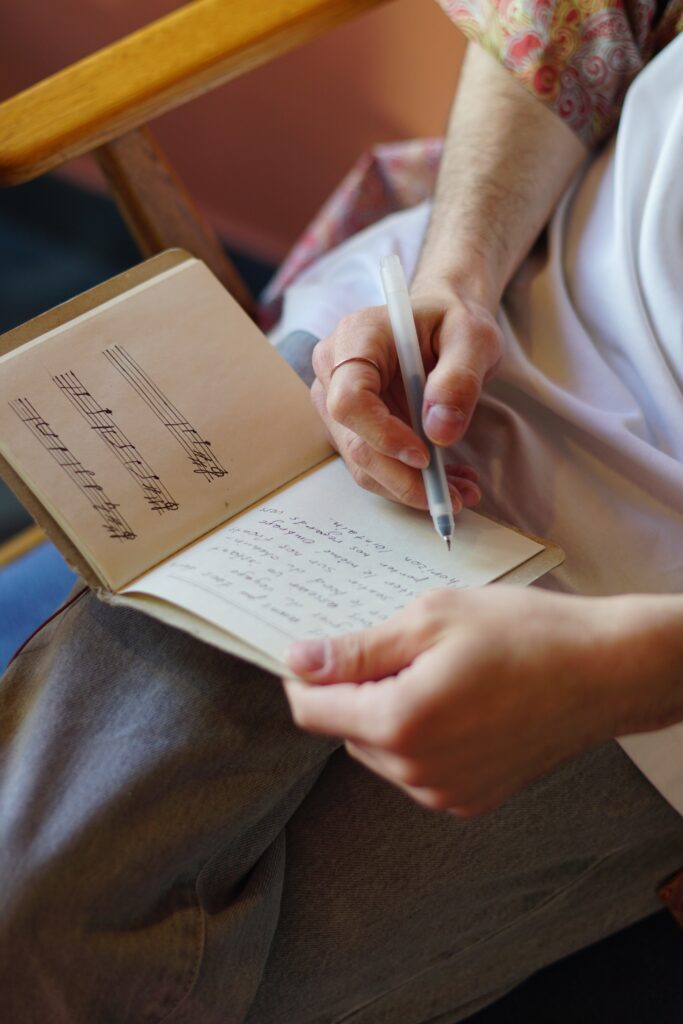Every writer has the tools to help tell his or her story. Pen and paper might be all you need to jot down the simplest of poems but as a songwriter, you need several tools, skills, and techniques to tell stories through song. Below I give you 7 tips and techniques I have used over the years to help create catchy melodies and harmonies for my songs.
- Practice Music Theory
- Listen and break down songs
- Singing is your new instrument
- Sing Music to No Lyrics
- Make a Parody
- Stop being so harsh on yourself
1. Practice Music Theory
Yes! Learn more theory. There is nothing wrong with advancing your skills because there will always be something new to learn. The minute you think you don’t need any more education in your life is when you begin to fall behind. We as humans are born to evolve and to keep evolving.
If chords, scales, and arpeggios come easily to you or you want to skip all that chord stuff, for the time being, consider taking a drum class to help advance your rhythm. Don’t own or can’t afford a drumset? No worries, bust out your wooden spoons, your pots and pans, and BAM! Your DIY drumset. What was it that Zac Efron said? “We’ll work this out?
2. Listen and break down songs
Another way you can practice music theory is by breaking down a song. One by one, take the song apart from guitars, bass, synths, 808s, vocals, and everything! Listen to what your favorite artists are playing and repeat it back by writing it down on paper or in your DAW. [Click here to learn more about DAWs (digital audio workstations)]
This is also a great opportunity to break down the words the songwriter chose. Understand why their choice of words worked so well with the melody, the harmonies, and the overall tone of the track. I also encourage you to listen to all sorts of genres! Especially musicals, their rhythms and choice of words are always changing throughout the song. Here’s an amazing musical with great production, an amazing cast, and incredible music.
3. Singing is your new instrument
Do you ever have trouble traveling with your keyboard or guitar? Don’t you wish there was a way you can magically add your instrument to a bottle where you can make it accessible to wherever you go?
No fear! Your voice is here to save the day! No seriously, the very best instrument you can use and take where ever you go. Will be your vocal cords. It’s okay if you’re voice is rusty or cringy. Using your voice will advance the melodies in your songs and let you hear harmonies you’ve never used before. If you are on the shy side, the best place where no one will judge you will be during your shower or on the car ride to work.
Beat Boxing and humming is singing
Now, ya’ll can disagree with me, but I truly believe beatboxing is a form of singing. You are using your embouchure, vocal cords, and air as an instrument to create a sound. Whether clicking your cheeks together to get a snare sound or adding a bit of bass in the back of your throat. That’s a form of singing!
4. Sing to Music with No Lyrics
Just Spit those Bars!
I practice creating melodies and harmonies with music that has no lyrics. This is where your music theory knowledge will kick in. If you are tone-deaf or lacking in musical understanding it will be difficult for you to find out the rhythm and style of music you are trying to portray.
Using Lofi beats or any stock music is a quick way to start building your rhythm and harmony chops. (Make sure you give credit/ask permission to the composer if you end up professionally using the songs for commercial use) Do it while you are driving to work, while you are cooking, or if your musician friend randomly plays a chord progression that sounds familiar to you. Spit out whatever sounds good in your head. Of course, it’s not always going to sound great and that is okay. That’s why it’s called practice and not performance.
5. Make a Parody
A great way to get better with rhythm in your lyrics is knowing the syllables within a word. Create a parody of a song you know by heart and change up the lyrics. If that seems difficult at first, try a song that already gives you a melody, but no actual lyrics.
Here’s a great one! This will help you focus on putting words that blend well together with the rhythm of the song. Put lyrics only to the Zabwe dap dooby doo parts. I also encourage you to be a part of the monkey gang and add a beat you hear in your head whether by beatboxing or humming.
6. Stop being so harsh on yourself
Look it’s good that you are putting a bit of pressure on yourself to get better, but let me tell you a little secret. YOU ARE YOUR WORST ENEMY. There has to be a point where you need to accept that not every song you write will be a #1 billboard hit. You win some, you lose some and that’s okay. Just don’t stop writing, practicing, and learning, then you’ll see progress.
I know these tips can help bring you confidence in adding rhythm to your lyrics and hopefully bring in a hit song! Do you have any tips or techniques that help you with the rhythm of your lyrics? Comment down below and let me know what helps you!
